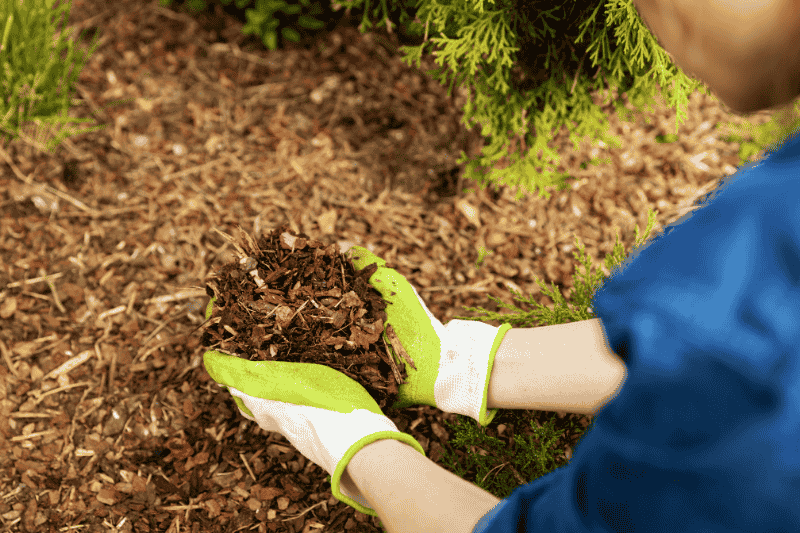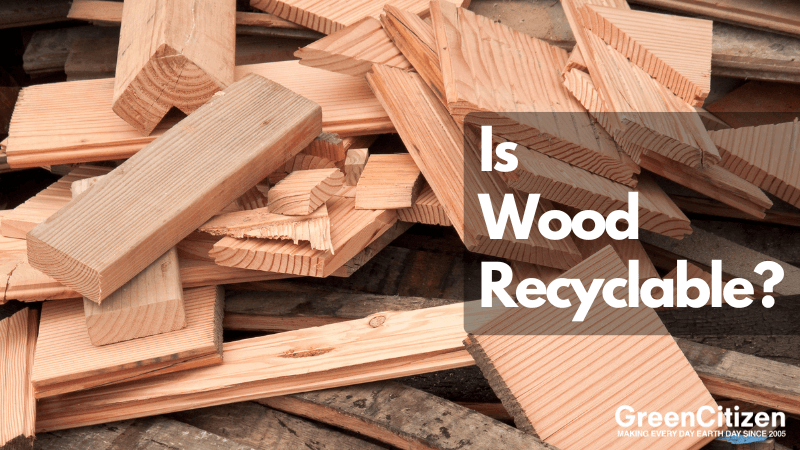Wood, a gift from Mother Nature, is everywhere around us. From the chair I’m sitting on to the bookshelf you admire, it’s a staple in our lives.
But as we both strive to be planet champions, a question popped into my mind – “Is wood recyclable?”
Yes, wood is generally recyclable, but you need to make sure it’s not treated with chemicals.
Understanding wood as a recyclable material is pivotal. It’s not just about the chair that breaks or the wooden spoon that’s seen better days. It’s about our planet and our shared commitment to sustainability.
And considering the immense role wood plays in our lives, it’s critical for us, the eco-conscious community, to dive into the importance of wood recycling.
Stick with me as we explore this together, and uncover how this natural resource intersects with our journey towards a greener tomorrow.
The Basics of Wood Recycling
What is Wood Recycling?
Wood recycling, as the name suggests, is all about giving our beloved timber another shot at life. Instead of allowing wood waste to rot or, even worse, end up in landfills, we repurpose and transform it.
The process begins at a wood recycling facility, where wood debris is sorted, cleaned, and prepped.
Through this, not only are we minimizing waste wood, but we’re also championing some fantastic environmental and economic benefits. Think about it; every piece of recycled wood reduces the need to cut down another tree and saves resources in the manufacturing process.
Different Types of Wood: Can They All Be Recycled?
Now, as you may guess, not all wood is made equal:
Hardwood and softwood: These are often found in furniture and construction. While both can be recycled, it’s crucial they are free from contaminants.
Untreated Wood: This is the dream for any wood recycling process. It’s easy to recycle, often turned into wood chips or used as yard waste composting.
Treated Wood: A bit more challenging. Painted wood, for instance, needs special care. Some treatments and paints can introduce toxins that require careful disposal.
Recycling Bin Woes: Ever stood by your recycling bin, piece of wood in hand, wondering if it belongs? You’re not alone. While untreated wood is a recycling bin’s best friend, treated or painted wood should be kept out.
Wood Chips: Often a result of wood recycling, these can be repurposed in a variety of ways, such as gardening or biomass.
To get the full low-down, a visit to a local wood recycling facility can offer some hands-on insight. Remember, while the goal is to recycle wood as much as possible, we must be wary of what we toss into the mix.
Making informed decisions on how to dispose of wood ensures that we’re genuinely contributing to the sustainability cycle.
What Are the Different Grades of Recycled Wood?

When we talk about wood recycling, it’s not just a simple process of tossing any old piece of lumber into a bin and hoping for the best.
Just as there are multiple types of wood products in our daily lives, from wooden pallets to intricate wood furniture, the recycling world classifies wood into various grades.
This ensures that each piece is reused in the most sustainable and efficient manner.
Grade A: Often derived from wooden pallets, Grade A is the poster child for clean wood recycling. With its pristine nature, it’s highly sought after for applications like bedding and mulch. Next time you admire a well-kept garden, it might just owe its charm to Grade A recycled wood.
Grade B: Think of Grade B as a blend of the clean wood from Grade A with construction waste. Given its composition, it’s dubbed as industrial-grade feedstock. It might not have the purity of Grade A, but it’s incredibly useful in crafting panel boarding, a common building material.
Grade C: If Grade A and B decided to team up and invite collections from municipalities to the party, you’d get Grade C. This wood finds its calling in the energy sector, being used predominantly for biomass fuel. It’s the eco-warrior, converting waste into energy.
Grade D: Now, here’s where things get a tad more complex. Grade D wood can be anything and everything – from treated to painted wood, and even trackwork or fencing. Because of its varied nature and potential hazards, disposing of it isn’t as straightforward. It’s seen as a bit of a renegade and must be sent to a special hazardous waste facility for proper handling.
It’s worth noting that while Grades A to C might occasionally find their way into your curbside recycling bin, Grade D requires special attention. Always ensure that any hazardous wood is kept separate and taken to the appropriate recycling facility.
How Can You Recycle Wood?
In our journey toward a more sustainable future, understanding how to properly recycle materials, especially something as ubiquitous as wood, is crucial. While we’ve delved into the intricacies of wood recycling processes, it’s now time to understand how you, as an individual, can contribute to this eco-friendly initiative.
Preparing Wood for Recycling
Before you toss your untreated wood or even treated wood pieces into the recycling stream, there are certain preparatory steps you should follow:
Cleaning: Ensure that your wood waste is free from any foreign materials like nails, screws, or other non-wood items. This not only helps in maintaining the quality of recyclable wood but also ensures safety at recycling facilities.
Sorting: Differentiate between untreated wood and treated wood. While most facilities accept untreated wood with open arms, treated wood might need special disposal methods due to the chemicals used in its treatment.
Size: If possible, cut or break the wood into manageable sizes. This ensures that the waste wood can be easily processed.
Dos and Don’ts When Preparing Wood for Recycling
Do’s
Don’ts
- Remove all hardware from wood
- Segregate yard waste from wood waste
- Check for any toxic chemicals in treated wood
- Mix treated wood with untreated wood
- Include wood with paint, stains, or other finishes in untreated wood piles
- Dispose of wood in the regular trash without checking its recycling potential first
Finding Local Wood Recycling Centers

So, you’ve sorted and prepared your wood for recycling. The next step is finding a place that’ll gladly take it off your hands:
- Research: The easiest way to find a local wood recycling center is by using online directories. One such reliable source is the Green Directory from GreenCitizen. This platform offers an extensive list of recycling centers, making it simpler for you to recycle wood responsibly.
- Contact: Before hauling your wood waste to a facility, always call ahead. Confirm what types of wood they accept, whether they have a curbside recycling program, or if there are any fees associated with wood disposal.
- Participation: Many municipalities and local communities offer regular wood recycling drives or events. Participate! It's a great way to ensure your wood waste gets recycled while being part of a community initiative.
Recycling wood is not just an environmental responsibility; it’s a commitment to the planet and future generations. Whether it’s a piece of yard waste or an old wooden artifact, remember, there’s always a sustainable way to dispose of wood.
The Wood Recycling Process: How Does It Happen?
1. Collection
At the heart of our recycling tips lies the art of collecting. The symphony of wood recycling begins in our homes, backyards, and construction sites. Whether it’s remnants of a recently renovated deck or an old, beloved chair, each wood piece has potential. Special collection bins and even curbside pickup, strategically placed, stand ready to receive these wooden memories.
2. Transportation
Mighty trucks, equipped to handle both treated lumber and untreated lumber, navigate streets with purpose. They’re on a mission to ferry our discarded treasures to places where magic happens – the recycling facilities.
3. Sorting
Within the recycling facility, an intricate dance of categorization takes place. The rich mahogany, the clean timber, and the easily recycled oak are recognized and separated. Treated lumber, especially those with harmful chemicals or even chromated copper arsenate, is carefully distinguished from its untreated counterparts.
4. Cleaning
This is where wood undergoes a spa treatment. Those wood pieces that have been stained or painted shed layers, revealing their authentic selves. Toxic chemicals, nails, and screws are meticulously extracted, ensuring the wood is pure.
5. Processing
Machines hum and buzz, turning large wood pieces into smaller fragments. For those curious about how wood makes its transformation, it’s a sight to behold. They chip, shred, and grind the wood, prepping it for its next role.
6. Repurposing
Here, the processed wood, whether from more trees or recycled sources, finds its new purpose. It might serve as nurturing mulch, form the core of sturdy panel boards, or energetically ignite for energy production, especially if it’s from untreated sources.
7. Treatment (if necessary)
Wood destined for special roles undergoes an additional layer of care. Some are bathed with treatments, shielding them from elements. However, it’s essential to note that you shouldn’t burn treated lumber in a fire pit due to harmful chemicals.
8. Distribution
The transformed wood products, now ready and eager, flow into various channels. Distributors, waiting for untreated lumber or other materials, stand ready.
9. Sale and Reuse
The cycle reaches its climax. Recycled wood products find their way into homes, standing as a testament to the fact that wood, unlike normal trash, can have multiple lives. And for those considering tossing their wood into a normal trash bin or burning it in their fire pit, remember the value of recycling.
How to Use Recycled Wood
Recycling isn’t just about making the earth greener; it’s about turning what’s old into something new and equally valuable.
Wood, in particular, showcases this transformational beauty, turning scrap lumber, old wood, and even tree branches into something functional and aesthetically pleasing.
The Many Faces of Recycled Wood

The process of reusing wood is both an art and a science, and the end products are a testament to this:
Chipboard: Often found in our homes as a staple for home improvement projects, chipboard is a common product made from recycled wood. The leftover wood, be it from construction sites or old furniture, is compressed and bonded together to create this versatile material.
Mulch: Anyone with a green thumb knows the value of mulch. The scrap wood and tree branches, which might otherwise end up unused, are chipped down and treated (using environmentally friendly wood treatment, of course) to become a gardener’s best friend.
Compost: As wood decomposes, it turns into a nutrient-rich substance ideal for plants. Recycling facilities that accept wood often have specialized processes to speed up this decomposition, turning wood trim, and even excess wood into valuable compost.
Animal Bedding: Your pets might be sleeping on recycled luxury. Wood, especially from sustainably managed forests, is sometimes chipped down into soft, absorbent materials, making perfect bedding for animals.
Popular Products from Recycled Wood
Recycling wood isn’t just about large-scale operations. Through curbside recycling programs and the diligent work of artisans, wood finds its way back into our lives in many forms:
- Furniture: Often, old wood, with all its character and history, is sought after by craftsmen. This wood, rich in stories, gets a new lease of life as unique furniture pieces.
- Construction Materials: The construction lumber we see at sites often has a percentage of recycled content. It's a win-win, making use of recyclable materials and reducing the need to cut down more trees.
- Art and Decor: Many artisans and DIY enthusiasts see the beauty in scrap wood and tree branches, turning them into art pieces or home décor items.
- Garden Accessories: Leftover wood or wood trim can be creatively repurposed into garden benches, planters, or trellises.
Remember, every piece of recycled wood, whether it’s from a grand old tree or leftover wood trim from a construction site, embodies the essence of sustainability.
By choosing products made from recycled and other recyclable materials, we’re taking steps to ensure our planet remains lush and vibrant for generations to come.
How to Dispose of Wood that Cannot Be Recycled
Even with our best intentions, not all wood is fit for the recycling process. Whether it’s due to harmful chemicals, advanced degradation, or the type of treatment it’s undergone, some wood simply can’t join the recycling stream.
So, what do you do with such wood?
Let’s explore responsible and sustainable disposal methods.
What Types of Wood Cannot Be Recycled?
- Treated Lumber: Treated wood, especially those processed with chromated copper arsenate, poses environmental concerns. These harmful chemicals can leach into the soil or water sources, posing risks to both humans and wildlife.
- Painted or Stained Wood: The paints, varnishes, and stains often contain toxic compounds that make the wood non-recyclable. This is especially true for older wood pieces which might have been painted with lead-based paints.
- Plywood and Composite Wood: These often contain glues, resins, and other materials which can complicate the recycling process.
Safe Wood Disposal Options

Landfills: While it might sound counter-intuitive, sometimes the landfill is the safest place for certain types of non-recyclable wood. They are designed to handle waste in a manner that minimizes environmental impact. However, it’s essential to confirm with your local landfill if they accept the specific type of wood you wish to dispose of.
Incineration: Some facilities can safely burn treated lumber or painted wood for energy production. The burning process in these facilities is done at extremely high temperatures, ensuring the harmful chemicals are broken down effectively.
Repurposing: Old wood, even if non-recyclable, can be repurposed for various home improvement projects. Think about using wood for art projects, crafting, or even as a rustic decorative element.
Local Waste Collection: Many municipalities offer special collection days for waste that can’t typically be recycled or thrown in the normal trash. Check your local waste management’s calendar for such events.
Precautions to Consider
- Avoid Burning at Home: Never burn treated lumber in your fire pit or fireplace. The harmful chemicals released can pose health risks and environmental concerns.
- Safety Gear: If handling or cutting non-recyclable wood, always use safety gear. The toxic chemicals can be harmful upon direct contact or inhalation.
- Stay Updated: Regulations and technologies change. What might not be recyclable today could have a solution tomorrow. Stay updated with your local recycling and waste management guidelines.
Disposing of wood that cannot be recycled requires a bit more effort and knowledge, but it’s essential for the health of our planet.
As we strive for sustainability, understanding the nuances of materials and their disposal becomes an invaluable tool in our eco-conscious toolkit.
Conclusion: Choose to Make A Difference
Wood, as natural as it may seem, holds a significant footprint on our planet. Whether it’s in the form of the furniture we sit on or the houses we live in, it’s everywhere, and its impact is profound.
Recycling wood, as we’ve delved into, isn’t just about repurposing old planks or beams. It’s an act that interweaves environmental responsibility with economic practicality.
Each time we choose to recycle wood, we’re reducing the strain on our forests, curbing the need to fell more trees, and conserving energy. Beyond the green canopy and oxygen production, forests are ecosystems teeming with life, and preserving them is a testament to our commitment to biodiversity.
On the economic front, wood recycling is a thriving industry that offers jobs, promotes innovation, and paves the way for sustainable solutions in construction, design, and beyond.
So, what’s the take-home message?
Simple: wood is too precious to waste.
Let’s be proactive. Every wooden piece in our homes, workplaces, or yards has potential, whether recyclable or not. By understanding its lifecycle, recycling possibilities, and safe disposal methods, we’re not just making eco-friendly choices but setting a precedent for future generations.
To a greener, more sustainable future, the choice is in our hands. Let’s make every piece of wood count.

